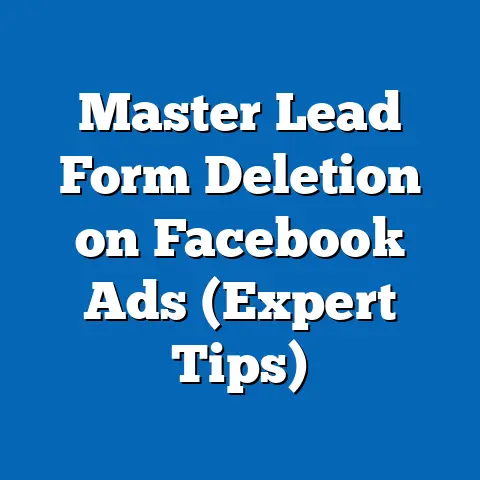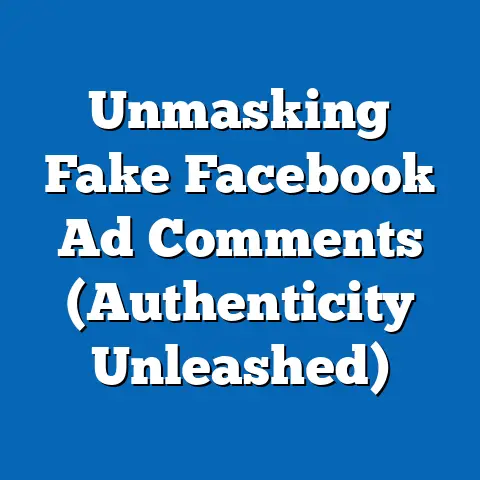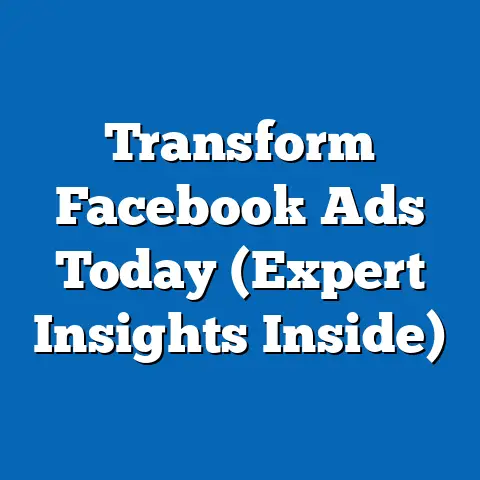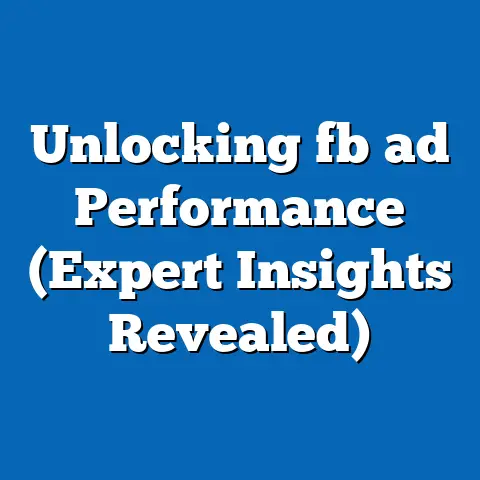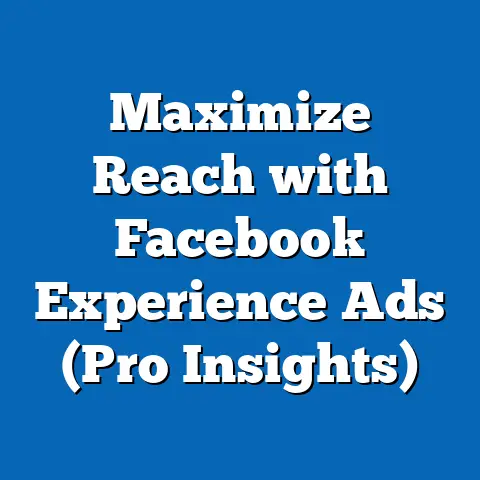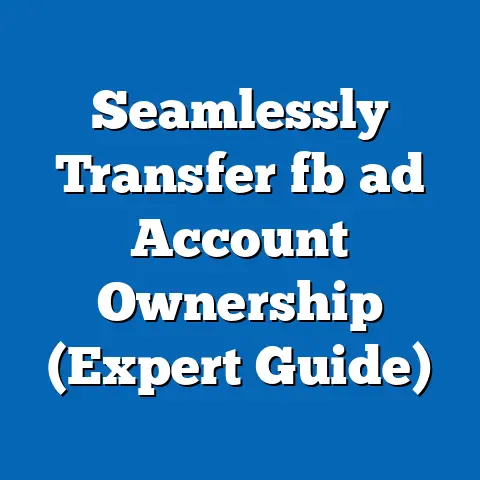Master Facebook & Instagram Ad Formats (Unlock Proven Success)
In the ever-evolving landscape of digital marketing, I believe that mastering Facebook and Instagram ad formats isn’t just an option; it’s the key to unlocking unparalleled success and driving unparalleled engagement for businesses of all sizes. I’ve seen firsthand how a well-crafted ad, perfectly tailored to the platform and audience, can transform a struggling campaign into a roaring success. It’s not about throwing money at ads; it’s about understanding the nuances of each format and leveraging them to tell your story in the most compelling way possible. This guide will delve into the heart of Facebook and Instagram advertising, providing you with the knowledge and tools to create ad campaigns that not only reach your target audience but also resonate with them, driving real results for your business.
Understanding the Importance of Facebook and Instagram Ads
Facebook and Instagram aren’t just social media platforms; they’re colossal advertising ecosystems. They represent a golden opportunity for businesses to connect with potential customers on a scale previously unimaginable. I’ve witnessed countless businesses, from small startups to established enterprises, leverage these platforms to achieve remarkable growth.
Let’s look at some compelling statistics. As of [insert current year], Facebook boasts approximately [insert current statistics] monthly active users, while Instagram isn’t far behind with [insert current statistics]. These numbers aren’t just impressive; they represent a vast pool of potential customers waiting to discover your product or service.
What truly sets Facebook and Instagram apart is their sophisticated targeting capabilities. I remember working with a local bakery that was struggling to attract new customers. By utilizing Facebook’s detailed targeting options, we were able to reach users interested in baking, desserts, and local businesses within a specific radius of the bakery. The result? A significant increase in foot traffic and online orders.
Takeaway: Facebook and Instagram are essential advertising platforms due to their massive reach and sophisticated targeting capabilities.
Overview of Ad Formats
The beauty of Facebook and Instagram advertising lies in the diverse range of ad formats available. Each format offers unique advantages and caters to different marketing objectives. I’ve spent years experimenting with these formats, and I’ve learned that choosing the right one is crucial for maximizing your campaign’s effectiveness.
Here’s a breakdown of the most popular ad formats:
- Image Ads: Simple yet effective, image ads are a great way to showcase your product or service with a visually appealing image and concise copy.
- Video Ads: Video ads are incredibly engaging and allow you to tell your story in a dynamic and captivating way. They’re perfect for demonstrating product features, sharing testimonials, or creating branded content.
- Carousel Ads: Carousel ads allow you to showcase multiple images or videos in a single ad unit. This format is ideal for highlighting different product features, telling a story in a sequence, or showcasing a collection of items.
- Slideshow Ads: Similar to video ads, slideshow ads combine multiple images with music and text to create a visually appealing and engaging experience. They’re a great alternative to video ads if you don’t have the resources to create high-quality video content.
- Collection Ads: Collection ads are designed for mobile shoppers and allow you to showcase a catalog of products in a visually appealing format. They’re perfect for driving traffic to your online store and increasing sales.
- Instant Experience Ads: Formerly known as Canvas ads, Instant Experience ads provide a full-screen, immersive experience on mobile devices. They’re great for telling a story, showcasing a product in detail, or creating an interactive experience.
- Stories Ads: Stories ads appear between users’ organic stories and offer a highly engaging and immersive experience. They’re perfect for reaching a younger audience and promoting time-sensitive offers.
- Reels Ads: Reels ads are short-form video ads that appear in the Reels feed. They’re a great way to tap into the viral potential of Reels and reach a large audience with engaging content.
Takeaway: Facebook and Instagram offer a diverse range of ad formats, each with its own unique advantages.
Deep Dive into Each Ad Format
Now, let’s delve deeper into each ad format and explore its best use cases, visual examples, and engagement metrics.
1. Image Ads
- Description: Image ads are the simplest and most common type of Facebook and Instagram ad. They consist of a single image, ad copy, and a call-to-action button.
- Best Use Cases: Image ads are ideal for showcasing a single product, promoting a specific offer, or driving traffic to your website.
- Visual Example: Think of a vibrant image of a new coffee blend from a local roaster, accompanied by the text “Try our new Ethiopian Yirgacheffe! Order online now.” The call-to-action button could be “Shop Now.”
- Engagement Metrics: Image ads typically have a lower engagement rate than video ads, but they can still be effective if the image is visually appealing and the copy is compelling. Key metrics to track include click-through rate (CTR) and conversion rate.
2. Video Ads
- Description: Video ads are dynamic and engaging, allowing you to tell your story in a visually appealing format.
- Best Use Cases: Video ads are perfect for demonstrating product features, sharing testimonials, creating branded content, or running contests.
- Visual Example: Imagine a short video of a chef demonstrating how to prepare a delicious meal using a specific brand of cookware. The video could include testimonials from satisfied customers and end with a call-to-action to “Shop Now.”
- Engagement Metrics: Video ads typically have a higher engagement rate than image ads, particularly in terms of video views and watch time. Key metrics to track include video completion rate, CTR, and conversion rate.
3. Carousel Ads
- Description: Carousel ads allow you to showcase multiple images or videos in a single ad unit.
- Best Use Cases: Carousel ads are ideal for highlighting different product features, telling a story in a sequence, showcasing a collection of items, or promoting a multi-step process.
- Visual Example: A clothing retailer could use a carousel ad to showcase different outfits for a specific season. Each card in the carousel could feature a different outfit, with a link to purchase each item.
- Engagement Metrics: Carousel ads can be highly effective in driving traffic to your website and increasing sales. Key metrics to track include CTR, conversion rate, and the number of swipes per ad.
4. Slideshow Ads
- Description: Slideshow ads combine multiple images with music and text to create a visually appealing and engaging experience.
- Best Use Cases: Slideshow ads are a great alternative to video ads if you don’t have the resources to create high-quality video content. They’re perfect for showcasing a product in detail, telling a story, or promoting an event.
- Visual Example: A travel agency could use a slideshow ad to showcase different destinations, with each slide featuring stunning images of the destination and accompanying text highlighting the key attractions.
- Engagement Metrics: Slideshow ads can be highly effective in driving engagement and generating leads. Key metrics to track include video completion rate, CTR, and conversion rate.
5. Collection Ads
- Description: Collection ads are designed for mobile shoppers and allow you to showcase a catalog of products in a visually appealing format.
- Best Use Cases: Collection ads are perfect for driving traffic to your online store and increasing sales.
- Visual Example: An e-commerce store selling home decor could use a collection ad to showcase a curated selection of products, with each product featuring a high-quality image and a link to purchase.
- Engagement Metrics: Collection ads are designed to drive sales, so the key metric to track is conversion rate. Other important metrics include CTR and the number of products viewed per ad.
6. Instant Experience Ads
- Description: Instant Experience ads provide a full-screen, immersive experience on mobile devices.
- Best Use Cases: Instant Experience ads are great for telling a story, showcasing a product in detail, creating an interactive experience, or hosting a virtual tour.
- Visual Example: A car manufacturer could use an Instant Experience ad to showcase the interior and exterior features of a new car model. The ad could include interactive elements, such as 360-degree views and the ability to customize the car’s color and features.
- Engagement Metrics: Instant Experience ads are designed to drive engagement, so key metrics to track include the amount of time spent in the experience, the number of interactive elements engaged with, and the conversion rate.
7. Stories Ads
- Description: Stories ads appear between users’ organic stories and offer a highly engaging and immersive experience.
- Best Use Cases: Stories ads are perfect for reaching a younger audience, promoting time-sensitive offers, running contests, or showcasing behind-the-scenes content.
- Visual Example: A restaurant could use a Stories ad to promote a limited-time menu item, with a swipe-up link to order online.
- Engagement Metrics: Stories ads are designed to drive engagement, so key metrics to track include the swipe-up rate, the number of views, and the conversion rate.
8. Reels Ads
- Description: Reels ads are short-form video ads that appear in the Reels feed.
- Best Use Cases: Reels ads are a great way to tap into the viral potential of Reels and reach a large audience with engaging content. They’re perfect for showcasing your brand’s personality, running challenges, or promoting trending products.
- Visual Example: A cosmetics brand could use a Reels ad to showcase a makeup tutorial, using their products to create a stunning look. The ad could include trending music and a call-to-action to “Shop Now.”
- Engagement Metrics: Reels ads are designed to drive engagement, so key metrics to track include the number of views, likes, comments, and shares.
Takeaway: Each ad format has its own unique strengths and weaknesses. Choose the format that best aligns with your marketing objectives and target audience.
Crafting Compelling Ads
Choosing the right ad format is only half the battle. To truly succeed on Facebook and Instagram, you need to craft compelling ads that capture attention and drive results. I’ve learned that a successful ad hinges on three key elements: visual appeal, copywriting, and a strong call to action.
- Visual Appeal: In the visually saturated world of social media, your ad needs to stand out. Use high-quality images and videos that are relevant to your target audience and brand. Consider using bright colors, eye-catching graphics, and professional photography.
- Copywriting: Your ad copy should be concise, engaging, and persuasive. Highlight the key benefits of your product or service and address your target audience’s pain points. Use strong verbs and active language to create a sense of urgency.
- Call to Action (CTA): Your call to action is the final push that encourages users to take the desired action. Use clear and concise language, such as “Shop Now,” “Learn More,” “Sign Up,” or “Get Started.” Make sure your CTA is visually prominent and easy to click.
I once worked with a fitness studio that was struggling to attract new members. Their initial ads featured generic stock photos and bland copy. By revamping their ads with high-quality images of real people working out in their studio and writing compelling copy that highlighted the benefits of their classes, we were able to significantly increase their lead generation.
Takeaway: Crafting compelling ads requires a combination of visual appeal, persuasive copywriting, and a strong call to action.
Targeting Your Audience
One of the most powerful features of Facebook and Instagram advertising is the ability to target your audience with incredible precision. This allows you to deliver your message to the people who are most likely to be interested in your product or service. I’ve seen firsthand how effective targeting can transform a failing campaign into a resounding success.
Facebook and Instagram offer a variety of targeting options, including:
- Custom Audiences: Custom Audiences allow you to target people who have already interacted with your business, such as website visitors, email subscribers, or customers.
- Lookalike Audiences: Lookalike Audiences allow you to target people who are similar to your existing customers. This is a great way to expand your reach and find new customers who are likely to be interested in your product or service.
- Interest Targeting: Interest targeting allows you to target people based on their interests, hobbies, and activities. This is a great way to reach a broad audience with relevant ads.
I remember working with an online bookstore that was struggling to reach new readers. By creating a Lookalike Audience based on their existing customer base and targeting users interested in specific genres of books, we were able to significantly increase their sales.
Takeaway: Effective audience targeting is crucial for maximizing the effectiveness of your Facebook and Instagram ad campaigns.
A/B Testing and Optimization
The journey to successful Facebook and Instagram advertising doesn’t end with creating and launching your ads. It’s an ongoing process of testing, analyzing, and optimizing. I’ve learned that A/B testing is essential for maximizing ad performance.
A/B testing involves creating two or more versions of an ad and testing them against each other to see which one performs better. You can A/B test different elements of your ad, such as the image, the copy, the call to action, or the targeting options.
Here’s how to set up A/B tests for different ad formats and content:
- Define your objective: What are you trying to achieve with your A/B test? Are you trying to increase your click-through rate, your conversion rate, or your lead generation?
- Choose your variables: What elements of your ad are you going to test?
- Create your variations: Create two or more versions of your ad, each with a different variation of the variable you’re testing.
- Set up your test: Use Facebook’s A/B testing tool to set up your test.
- Analyze your results: After your test has run for a sufficient amount of time, analyze your results to see which version of your ad performed better.
- Refine your ads: Based on your results, refine your ads and continue testing to further optimize your performance.
I once worked with a SaaS company that was struggling to generate leads through their Facebook ads. By A/B testing different headlines and calls to action, we were able to identify the combination that generated the most leads.
Takeaway: A/B testing is essential for maximizing the performance of your Facebook and Instagram ad campaigns.
Success Stories
The proof is in the pudding, as they say. Let’s take a look at some success stories from businesses that have effectively utilized Facebook and Instagram ad formats.
- Example 1: A Local Restaurant: A local restaurant used Stories ads to promote a limited-time menu item. By targeting users within a specific radius of the restaurant and offering a special discount, they were able to significantly increase their sales during the promotional period.
- Example 2: An E-commerce Store: An e-commerce store used Collection ads to showcase a curated selection of products. By targeting users interested in specific categories of products and offering free shipping, they were able to significantly increase their online sales.
- Example 3: A Fitness Studio: A fitness studio used video ads to showcase their classes and facilities. By targeting users interested in health and fitness and offering a free trial, they were able to significantly increase their lead generation.
The key lessons learned from these case studies are:
- Target your audience effectively: Use Facebook and Instagram’s targeting options to reach the people who are most likely to be interested in your product or service.
- Create compelling ads: Use high-quality images and videos, write persuasive copy, and include a strong call to action.
- Test and optimize: Continuously test and refine your ads to maximize their performance.
Takeaway: Success stories demonstrate the power of Facebook and Instagram advertising when used effectively.
Future Trends in Facebook and Instagram Advertising
The world of social media advertising is constantly evolving, and it’s important to stay ahead of the curve. Let’s explore some emerging trends that could impact Facebook and Instagram ad formats.
- Augmented Reality (AR): AR is likely to play an increasingly important role in social media advertising. Imagine being able to try on clothes virtually or see how furniture would look in your home before you buy it.
- Artificial Intelligence (AI): AI is already being used to personalize ads and optimize campaigns. In the future, AI could be used to create ads automatically and target users with even greater precision.
- Evolving User Behavior: As user behavior continues to evolve, ad strategies will need to adapt. For example, as more users shift to mobile devices, it will be increasingly important to create mobile-friendly ads.
Takeaway: Staying ahead of emerging trends is crucial for maintaining a competitive edge in the world of Facebook and Instagram advertising.
Conclusion: The Path to Proven Success
Mastering Facebook and Instagram ad formats is no longer a luxury; it’s a necessity for any business looking to thrive in the digital age. By understanding the diverse range of ad formats available, crafting compelling ads, targeting your audience effectively, and continuously testing and optimizing your campaigns, you can unlock unparalleled success and drive real results for your business.
The ability to effectively utilize these formats is crucial for any business looking to thrive in the digital marketing realm. The world of Facebook and Instagram advertising is constantly evolving, and it’s important to stay up-to-date on the latest trends and best practices. I encourage you to take action and start experimenting with the ad formats discussed in this guide. The possibilities are endless, and the potential rewards are enormous. Don’t be afraid to try new things, test different approaches, and learn from your mistakes. The key is to be persistent, patient, and always willing to adapt to the ever-changing landscape of social media advertising. Now go out there and create some amazing ads!

